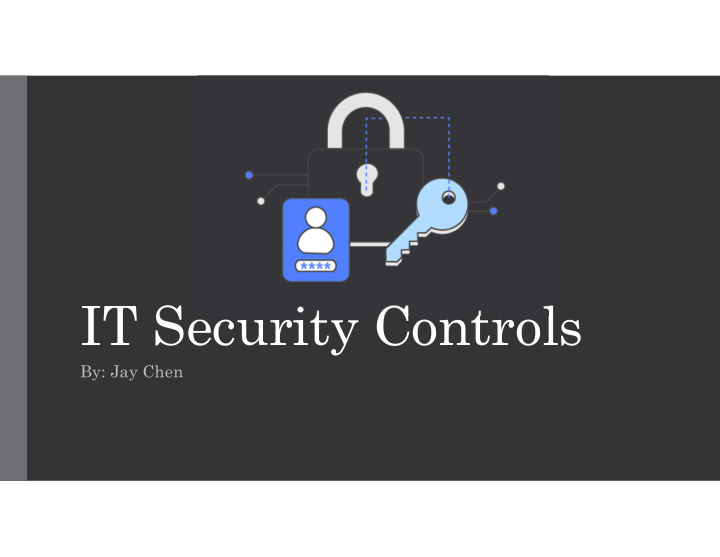



IT Security Controls By: Jay Chen
What are IT Security Controls? • Safeguards or countermeasures to avoid, detect, counteract, or minimize security risk • Types of Controls Preventive Controls (E.g. Password lockout after 5 failed attempts) Detective Controls (E.g. Intrusion Detection System (IDS) Alerting on Attacks) Corrective Controls (E.g. Patch management, Incident Response Team) Physical Controls (E.g. Locks, fences, doors) Procedural Controls (E.g. Security awareness training, incident response plan) Technical Controls (E.g. Anti-virus, firewall, user authentication) Legal Controls (E.g. Policies)
Why do we need IT Security Controls? • Laws and regulations (HIPAA, PCI, GDPR) • Protect critical infrastructure • Ensure the CIA Triad • Prevent security incidents “Global Average Cost of a data breach is $3.86 million” “Average cost for each stolen record is $148 per record” https://securitytoday.com/articles/2018/07/17/the-average-cost-of-a-data-breach.aspx
Regulations and Industry Standards • HIPAA (Healthcare) • FERPA (Education) • FISMA (Government) • State Laws – NY DFS (Financial) • International Laws – GDPR (EU) • Industry Standards – PCI DSS (Payment Processors)
So how do we ensure we have the correct IT controls?
By using frameworks
What is a security framework? • A framework consisting of policies, procedures, and processes that define how information is managed in a business, to lower risk and vulnerability • A framework is not: A regulation A legislation • However, a framework is a best practice
List of Security Frameworks • COBIT Created by ISACA Risk Management Framework • ISO 27000 Series Created by International Organization for Standardization (ISO) Information Security Standards • NIST SP 800 Series ( https://csrc.nist.gov/publications/sp800) Created by National Institute of Standards and Technology Technology/Computer Security Frameworks and Guidelines 100+ SP Series Publications Highlights 800-53 (Security and Privacy Controls for Information Systems and Organizations) 494 Pages 800-37 (Risk Management Framework) 800-12 (An Introduction to Information Security) 800-121 (Guide to Bluetooth Security) 800-184 (Guide for Cybersecurity Event Recovery) 800-115 (Technical Guide to Information Security Testing and Assesment)
List of Security Frameworks • PTES (Penetration Testing Execution Standard) Created by a group of information security practitioners http://www.pentest-standard.org/index.php/Main_Page • NIST Cybersecurity Framework (NIST CSF) Created by National Institute of Standards and Technology A shorten 800-53 for private sector businesses • HiTrust CSF (Health Information Trust Alliance Common Security Framework) Cybersecurity Framework for healthcare industry (HIPAA) • CIS Top 20 Created by Center for Internet Security Top 20 Security Controls
CIS Top 20 • Center for Internet Security Top 20 Controls • CIS Top 20 Critical Security Controls is a prioritized set of best practices created to stop the most pervasive and dangerous threats. • 3 Tier Implementation Level • CIS Category Basic CIS Controls Foundational CIS Controls Organizational CIS Controls
Basic CIS Controls (Technology)
Foundational CIS Controls (Technology)
Organizational CIS Controls (People & Process)
Analyzing CIS Controls
CIS Control 1 Implementation Guide
What is NIST CSF? • NIST Cybersecurity Framework • Created by the National Institute of Standards and Technology (NIST) • The NIST cybersecurity framework separate into five cores Identify Detect Protect Response Recover • These five cores represents industry standards, guidelines, and practices for cybersecurity activities across an organization.
NIST Cybersecurity Framework
Identify • Develop an organizational understanding to manage cybersecurity risk to systems, people, assets, data, and capabilities.
Protect • Develop and implement appropriate safeguards to ensure delivery of critical services.
Detect • Develop and implement appropriate activities to identify the occurrence of a cybersecurity event.
Respond • Develop and implement appropriate activities to take action regarding a detected cybersecurity incident.
Recover • Develop and implement appropriate activities to maintain plans for resilience and to restore any capabilities or services that were impaired due to a cybersecurity incident.
Control Breakdown Functions # of Subcategory (Controls) Identify 29 Protect 39 Detect 18 Respond 16 Recover 6 Total 108
NIST CSF Structure (Categories)
NIST CSF Structure (Subcategories)
NIST CSF Structure
NIST CSF Structure
NIST CSF (First Two Controls)
NIST CSF Mapping
CIS Control Mapping
The End • Questions?
Recommend
More recommend